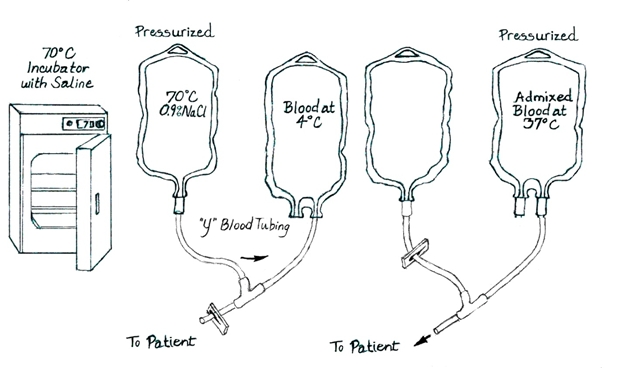Rapid Admixture Blood Warming: Fast, Safe & Inexpensive
Abstract
       The international standard for banked blood, including packed red blood cells (PRBCs), requires keeping it at 4ºC. Patients who need rapid PRBC unit transfusions benefit tremendously from blood being warmed to body temperature (37ºC), since hypothermia resulting from rapid infusion of cold blood is a major risk factor in exanguinating patients. It increases morbidity and mortality as well as often producing other adverse reactions, including those simulating transfusion reactions. Ideally, methods to warm blood for rapid transfusion should bring the unit to body temperature (37ºC), and be rapid, safe and inexpensive.           In most centres, clinicians’ ability to adequately warm PRBC units suffers from the time constraints of needing to infuse blood quickly, the frequent need to infuse blood simultaneously through multiple IV lines, and the cost and availability of blood-warming equipment. There are three methods available for re-warming PRBC units: passive warming towards room temperature (inadequate), in-line warming (slow or extremely expensive), and pre-warming.            This paper describes a safe, rapid and inexpensive method to pre-warm PRBC units. The only piece of capital equipment needed for this process is a standard 70ºC laboratory incubator in which to preheat 250 0.9 normal saline (NS) bags. Only one incubator, which generally lasts for decades, is needed for an emergency department, operating room, or intensive care unit; if they are in close proximity, only one is needed for all of them.           Published studies and extensive clinical experience have shown that this method not only is safe and easy to use, but also preserves erythrocyte integrity and survival time. Rapid admixture blood warming is so inexpensive, simple, safe, and fast that it can and should be the primary method used for blood warming in most parts of the world.References
1. Iserson KV, Huestis D. Blood warming techniques—current applications and techniques. Transfusion 1991;31:6:558-571.
2. Iserson KV. Improvised Medicine: Providing Care in Extreme Environments NY:McGraw-Hill, 242-3, 2012.
3. Iserson KV. Rapid High Volume Fluid Infusions, in Roberts J, Hedges J, Clinical Procedures in Emergency Medicine, 2nd ed., Philadelphia:W.B. Saunders, 301-307, 1991.
4. Iserson KV, Judkins D. Admixture blood warming. J Trauma 1994; 36:3:461-2.
5. Iserson KV, Knauf MA, Anhalt D. Rapid admixture blood warming—technical advances. Crit Care Med 1990;18:10:1138-1141.
6. Wilson EB, Knauf MA, Donohoe K, Iserson KV. Red blood cell survival following admixture with heated saline—evaluation of a new blood warming method for rapid transfusion. J Trauma 1988;28:8:1274-1277.
7. Wilson EB, Knauf MA, Iserson KV. Red cell tolerance of admixture with heated saline. Transfusion 1988;28:2:170-172.
2. Iserson KV. Improvised Medicine: Providing Care in Extreme Environments NY:McGraw-Hill, 242-3, 2012.
3. Iserson KV. Rapid High Volume Fluid Infusions, in Roberts J, Hedges J, Clinical Procedures in Emergency Medicine, 2nd ed., Philadelphia:W.B. Saunders, 301-307, 1991.
4. Iserson KV, Judkins D. Admixture blood warming. J Trauma 1994; 36:3:461-2.
5. Iserson KV, Knauf MA, Anhalt D. Rapid admixture blood warming—technical advances. Crit Care Med 1990;18:10:1138-1141.
6. Wilson EB, Knauf MA, Donohoe K, Iserson KV. Red blood cell survival following admixture with heated saline—evaluation of a new blood warming method for rapid transfusion. J Trauma 1988;28:8:1274-1277.
7. Wilson EB, Knauf MA, Iserson KV. Red cell tolerance of admixture with heated saline. Transfusion 1988;28:2:170-172.

